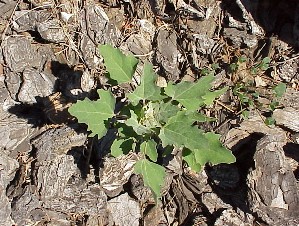Scientific name: Chenopodium album L.
Common name: Fat-hen, White goosefootFamily: ChenopodiaceaeOrigin:A cosmopolitan weed. Habit:Large annual herb with erect branches to 2 m tall. Habitat:Common and widespread weed found in cultivation, gardens and along roadsides and footpaths. General description:Stems and leavesThe stems are ridged longitudinally. They are upright green to reddish in colour, with a grey mealy surface. Leaves are alternately arranged with leaf stalks (petioles) 0.5-5 cm long. They vary in size (1-8 × 0.3-6 cm) and shape (from nearly egg-shaped to long and narrow), depending on the age of the plant and their position on the stem. The leaf margin varies from being wavy or toothed on the lower leaves to being entire on some upper leaves. The leaves usually have white mealy undersides. Flowers and fruitThe flowers are small, greenish-white and crumb-like in appearance. They are borne on branched inflorescences on the upper part of the plant. Flowering and fruiting occurs over most of the year. When mature, the fruit are often enclosed by papery sepals. Seeds are shiny black discs measuring 1.2-1.8 mm across. Up to half a million seeds can be produced per plant. Distinguishing characteristics:An erect annual with large numbers of inconspicuous greenish-white flowers and toothed or wavy leaves. Chenopodium album (fat-hen) looks very similar to Chenopodium ambrosioides (Mexican tea) but lacks the strong unpleasant odour of this species. It has whitish flowers while Chenopodium ambrosioides has green flowers. Noxious status:Not noxious. Sources:Friend, E. (1983). Queensland Weed Seeds. Department of Primary Industries, Brisbane. Kleinschmidt, H.E., Holland, A. and Simpson, P. (1996). Suburban Weeds. 3rd Edition. Department of Primary Industries, Brisbane. Stanley, T.E. and Ross, E.M. (1983-1989). Flora of South-eastern Queensland. Volume 1. Department of Primary Industries, Brisbane. |
Brisbane
St Lucia, QLD 4072
+61 7 3365 1111
© 2009 The University of Queensland

